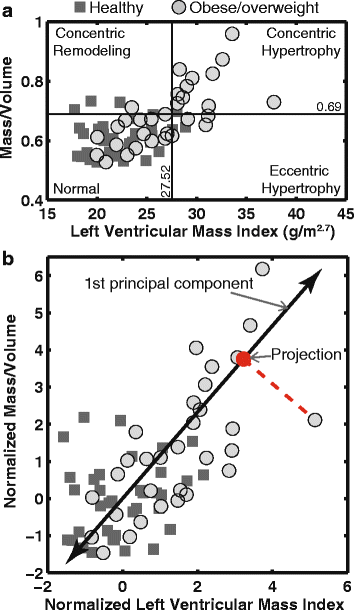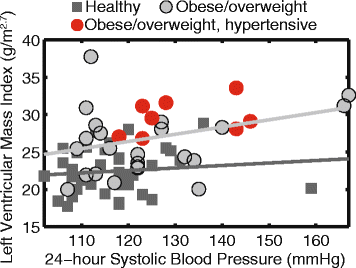Ambulatory systolic blood pressure and obesity are independently associated with left ventricular hypertrophic remodeling in children
- PMID: 29117866
- PMCID: PMC5679494
- DOI: 10.1186/s12968-017-0401-3
Ambulatory systolic blood pressure and obesity are independently associated with left ventricular hypertrophic remodeling in children
Abstract
Background: Children with obesity have hypertrophic cardiac remodeling. Hypertension is common in pediatric obesity, and may independently contribute to hypertrophy. We hypothesized that both the degree of obesity and ambulatory blood pressure (ABP) would independently associate with measures of hypertrophic cardiac remodeling in children.
Methods: Children, aged 8-17 years, prospectively underwent cardiovascular magnetic resonance (CMR) and ABP monitoring. Left ventricular (LV) mass indexed to height2.7 (LVMI), myocardial thickness and end-diastolic volume were quantified from a 3D LV model reconstructed from cine balanced steady state free precession images. Categories of remodeling were determined based on cutoff values for LVMI and mass/volume. Principal component analysis was used to define a "hypertrophy score" to study the continuous relationship between concentric hypertrophy and ABP.
Results: Seventy-two children were recruited, and 68 of those (37 healthy weight and 31 obese/overweight) completed both CMR and ABP monitoring. Obese/overweight children had increased LVMI (27 ± 4 vs 22 ± 3 g/m2.7, p < 0.001), myocardial thickness (5.6 ± 0.9 vs 4.9 ± 0.7 mm, p < 0.001), mass/volume (0.69 ± 0.1 vs 0.61 ± 0.06, p < 0.001), and hypertrophy score (1.1 ± 2.2 vs -0.96 ± 1.1, p < 0.001). Thirty-five percent of obese/overweight children had concentric hypertrophy. Ambulatory hypertension was observed in 26% of the obese/overweight children and none of the controls while masked hypertension was observed in 32% of the obese/overweight children and 16% of the controls. Univariate linear regression showed that BMI z-score, systolic BP (24 h, day and night), and systolic load correlated with LVMI, thickness, mass/volume and hypertrophy score, while 24 h and nighttime diastolic BP and load also correlated with thickness and mass/volume. Multivariate analysis showed body mass index z-score and systolic blood pressure were both independently associated with left ventricular mass index (β=0.54 [p < 0.001] and 0.22 [p = 0.03]), thickness (β=0.34 [p < 0.001] and 0.26 [p = 0.001]) and hypertrophy score (β=0.47 and 0.36, both p < 0.001).
Conclusions: In children, both the degree of obesity and ambulatory blood pressures are independently associated with measures of cardiac hypertrophic remodeling, however the correlations were generally stronger for the degree of obesity. This suggests that interventions targeted at weight loss or obesity-associated co-morbidities including hypertension may be effective in reversing or preventing cardiac remodeling in obese children.
Keywords: Ambulatory blood pressure monitoring; Cardiovascular magnetic resonance; Hypertension; Pediatric obesity; Ventricular remodeling.
Conflict of interest statement
Ethics approval and consent to participate
The study was approved by Institutional Review Boards at both the University of Kentucky (13–0201-P6H) and Geisinger Health System (2015–0159). All subjects provided assent and their parents/legal guardians provided written and informed consent.
Consent for publication
Not applicable.
Competing interests
The authors declare that they have no competing interests.
Publisher’s Note
Springer Nature remains neutral with regard to jurisdictional claims in published maps and institutional affiliations.
Figures




References
-
- Di Salvo G, Pacileo G, Del Giudice EM, Natale F, Limongelli G, Verrengia M, Rea A, Fratta F, Castaldi B, D’Andrea A, Calabrò P, Miele T, Coppola F, Russo MG, Caso P, Perrone L, Calabrò R. Abnormal myocardial deformation properties in obese, non-hypertensive children: an ambulatory blood pressure monitoring, standard echocardiographic, and strain rate imaging study. Eur Heart J. 2006;27:2689–2695. doi: 10.1093/eurheartj/ehl163. - DOI - PubMed
MeSH terms
Grants and funding
LinkOut - more resources
Full Text Sources
Other Literature Sources
Medical

